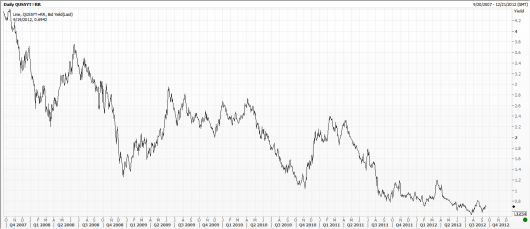The quiet before the storm
Merger & acquisition (M&A) markets have remained very quiet over the past few months, with the exception of a few large strategic deals. The key […]
Merger & acquisition (M&A) markets have remained very quiet over the past few months, with the exception of a few large strategic deals. The key […]
Merger & acquisition (M&A) markets have remained very quiet over the past few months, with the exception of a few large strategic deals. The key reason is uncertainty across the whole global economy, mainly around Europe but also some unease around the engineering slowdown in China. Total M&A activity (as measured by Bloomberg) dipped to around US$413 billion in the third quarter of 2012 compared to US$662 billion in the fourth quarter of 2010. If we go back to the frenzy leading up to the global crisis, M&A activity hit around US$1.3 trillion in the second quarter of 2007 so we are currently at around a third of those levels, despite the Dow Jones Industrial Average trading only 4% below its high in the second quarter of 2007.
One of the largest deals this year has come from the Asian region – China National Offshore Oil Corporate (CNOOC) pitch for Nexen in July worth around US$17.4bn. This ranks second only to Glencore’s merger with Xstrata worth around US$46.7bn, but is a stock only deal unlike CNOOC’s cash pitch for Nexen.
Decision makers running businesses at the executive level know very well the risk of overpaying for assets that do not perform in the short term and understandably so. It takes a lot of courage to initiate M&A activity in such uncertainty. Equity markets are also in a very conservative phase – any business which even slightly disappoints gets punished, further removing the incentive to go out and do deals that may or may not pay off. Most deals are based on an acquisition multiple – this requires a stable earnings base in order to better value a business. With so much uncertainty around, it is hard to find this solid earnings base in many global businesses which makes doing deals even harder.
But one of the most important aspects of an M&A trend is the cost and availability of obtaining debt. As the spread between yields on listed companies and bond yields grows, the temptation to get on the front foot is too hard to resist for many companies. As the Fed chews up US$40 billion of mortgage paper a month, banks will have to find other areas to put their balance sheet to use. Writing loans and flicking them off to the Fed provides the ability to go out and write more corporate loans. This comes at a time in the US corporate bond market where treasuries are at unsustainably low levels. Investors are starting to scramble for yield, hence the perfect storm for a huge rise in M&A activity. Yesterday’s news that Fortescue Metals was able to secure US$4.5 billion in new five year funding shows banks are starting to roll up their sleeves.
The chart below (Source: Reuters) shows the yield of five year US treasuries – the return investors get for parking their money in treasuries over a fixed five year period. The yield has fallen from over 4% in late 2007 to less than 0.7% today. If we go back to the 1990s the rate of return was somewhere in excess of 7.5%. When you can fund an asset at around 2-3% at a corporate level and receive a return of 6-7% as currently implied by the S&P500 index, then the spread starts to get very attractive and it is only a matter of time where listed companies are faced with the option of growing or being themselves a target for takeover. M&A markets should be closely watched over the next few weeks should a trend emerge into the fourth quarter of this year. Cheap, readily available debt, low company debt and a moderation in Europe’s problems could all form the perfect storm for M&A markets.
